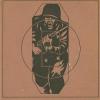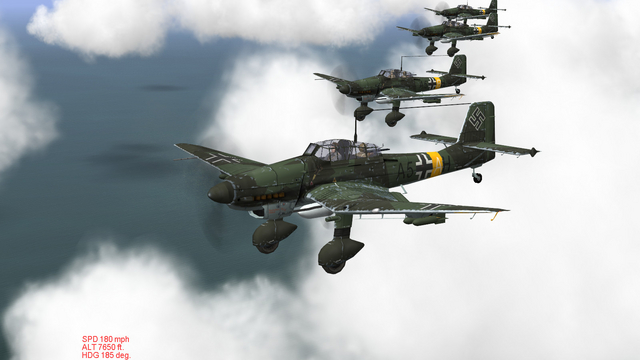Search the Community
Showing results for tags 'stuka'.
Found 3 results
-
Flying the Ju 87 over the front on the Volga - in Il-2 1946! Why fly the Stuka in 'classic' Il-2 - over Stalingrad, to boot - when you can fly it in Il-2: Battle of Stalingrad (BoS)? If you have access to both sims, that's a good question. The new sim models the Stuka to a level of detail that is visually much superior, plus BoS portrays the city and the battlefield around it in tremendous detail. See what I mean? Well, there are three reasons for playing this mission in the earlier sim, in my case. Firstly, I want to to make a comparison - to feature Stuka campaign mission reports from both sims, one after the other. Secondly, flying the Stuka and some Soviet fighers in the newer sim actually spurred me to do something I had only dabbled in before - start some serious Eastern Front campaigns in the older sim, for the VVS and flying the Stuka. And the third reason is this: At the moment, AI-flown Stukas in BoS regularly crack up soon after takeoff, often leaving you on your own, after your flight-mates have fire-balled or belly-flopped onto the snow. Well, that's the result I'm getting anyway, and I'm not alone. The solution, for now, appears to be - fly an air start. So that's likely what I'll do, for the next mission report. But for his one, I'm starting with the original sim. Well, not quite the original, since what we have now is a sim that's had about thirteen years development and modding. Here, I'm using Il-2 1946 with the latest Dark Blue World mod installed. The mission itself is, I believe, from a stock Stuka campaign. This is divided into several mini-campaigns, starting early on during Operation Barbarossa and extending to the Battle of Kursk and beyond. Having created a new pilot with the surname of the most famous and successful Stuka pilot, I was pleased to find out that I could go straight to the Battle of Stalingrad. So that's what I did. The Il-2 '46 Stuka has a comparatively lower-polygon 3d model but it's still a pleasing replica. Moreover, the sim features several Ju 87 variants, notably the early-war B version; the more angular D version most common on the Eastern Front; and the G model tankbuster with two 3.7 cm cannon. Here's the plane I'll be flying now, a Ju 87D-3. It has the correct fuselage code (A5+AH) for the campaign's unit, the 1st Staffel in I Gruppe, Stukageschwader 1 - 'A5' signifying StG1 and 'H' indicating the 1st Staffel, which is in I Gruppe. The second 'A' is my individual aircraft letter; one of IL-2's nice touches is of course that other aircraft not only also have the correct unit markings, they each have different, individual aircraft letters. A virtual tour of operations with an historical sqaudron is one thing that you don't get in BoS for now. In Il-2 '46 you do and you can look up your unit roster, where you can keep track of your comrades and your relative success...or the lack thereof, as the case may be. I dislike flying as a wingman, preferring the tactical challenges of flight leadership. So for my pilot, I have selected the rank of Hauptman, which I hope will give me plenty of opportunity to show my mettle as a Stuka leader...or again, the lack thereof, as the case may be. Here's the briefing for my first mission. We're kicking off in mid-September, just before 6th Army's first big attack into the city of Stalingrad itself; the snows and the first Soviet encircling attacks are still a couple of months away. In the second screenshot below, I have scrolled down the text to show how Il-2 lists your flight's composition, which BoS doesn't; though like BoS, I'm only going to find out that we've got an escort when I start the mission itself. And here we are on the runway, six Stukas in single file, with no less that eight Bf 109s lined up behind us. With an escort like that, surely we should be quite safe from any Bolsheviks foolish enough to try conclusions with the might of the Jagdwaffe! One way or another, I would find out, soon enough. ...to be continued!
-
American Warplane’s Forgotten Nazi Past The A-10 has been the favorite plane of American grunts for decades. But it was one of America’s most fearsome enemies who helped inspire the design of the so-called “Warthog.” The U.S. Air Force’s A-10 is an ugly, low-flying, slow-moving beast of an aircraft known affectionately by the troops as the Warthog. But even as the flying tank gets ready to shred ISIS terrorists to pieces over Iraq and Syria with its massive 30mm cannon-- firing depleted uranium shells the size of a Coke bottle--it hides a dark secret: an unrepentant Nazi fighter pilot helped to develop the ungainly warplane. Engineer Pierre Sprey, a former Pentagon procurement official who helped design the A-10, confirmed to The Daily Beast that none other than legendary Luftwaffe Colonel Hans-Ulrich Rudel was consulted to develop the Warthog. “While we were readying the airplane and gun for full scale production, the 30mm gun program manager, Col. Robert Dilger, invited Rudel to lead a symposium in DC attended by several hundred engineers, analysts, tacticians and intel types on all aspects of CAS [close air support] operations in combat,” Sprey told the Daily Beast. “For lots of them it was eye-opening. I translated for Rudel who spoke very little English.” Rudel was the Nazi-era Wehrmacht’s (which included the Heer, Kriegsmarine and Luftwaffe) most highly decorated officer and the only man to have been awarded the Knight's Cross of the Iron Cross with Golden Oak Leaves, Swords and Diamonds. During his wartime career, Rudel flew over 2,530 combat sorties over the Eastern Front against the Soviet Union and amassed a combat record of over 2,000 targets destroyed--800 vehicles, 519 tanks, 150 artillery pieces, 70 landing craft, nine aircraft, four armored trains, several bridges, a destroyer, two cruisers, and the Soviet battleship Marat. “Rudel was certainly the expert on killing Soviet tanks, 519 of them. But he was also brilliant on tactics—both ground and air—training, C3 [Command, Control & Communication], reconnaissance and squadron leadership,” Sprey said. “During our concept design phase, I required every member of the team to read Stuka Pilot, Rudel's superbly detailed recounting of his combat experiences, in order to understand the most crucial combat effectiveness characteristics of a CAS fighter.” Indeed, many of the characteristics of the Warthog, which is a darling of ground troops fighting in close proximity to enemy forces, were directly influenced by Rudel’s experience flying the Junkers Ju-87 Stuka dive-bomber and the ground-attack version of the Focke-Wulf 190D-9 fighter against the Soviet Red Army. “The book most certainly influenced me, particularly regarding how critical it was to incorporate in any effective CAS design such things as cockpit armor, fire suppression, need for ultra-tight turn radius maneuvering performance, ability to fly under 500ft weather, getting 3-5 sorties per day per plane, large caliber cannon, ability to move a squadron overnight, and ability to operate sustainably from unprepared fields--grass, dirt, mud, gravel, etc,” Sprey said in an email. However, as good a fighter pilot as Rudel was, it is an undeniable fact the he was an unrepentant Nazi and devotee of Adolf Hitler. After, the war Rudel—who became a relatively successful businessman--continued to advocate for the Third Reich and its genocidal, racist policies. One example of that: Rudel was a prominent member of the neo-Nazi German Reich Party from 1953 onward. Others within the U.S. Air Force dismiss Rudel’s impact on the A-10 design. “Frankly, I’m not sure why he would be consulted, Rudel was a statistical outlier in life-expectancy for ground-attack pilots in the Luftwaffe,” one Air Force official told The Daily Beast. Further, the Air Force official poured some cold water on the legacy of the Warthog—despite its popularity with the ground troops. “There is so much myth and half-truth wrapped around the A-10,” the official said. It’s a common sentiment in some corners of the Air Force, which has been looking to jettison the A-10 for decades. The Air Force wants to replace the Warthog because the jet would be hopelessly vulnerable against a modern enemy like China or Russia even if the aircraft can handle itself against relatively primitive enemies in Iraq or Syria. Instead of the slow-moving, low-flying A-10, the Air Force would prefer to use the stealthy $400 billion F-35 stealth fighter for future wars. Thus far, Congress has prevented the service from putting the Warthog out to pasture. The Air Force has some valid reasons for its view. One example cited by the Air Force official was the 1973 Yom Kippur war, when Israel was attacked by Egypt and Syria. The official pointed out that low and slow flying ground attack planes directly supporting the ground infantry were easy prey to even 1970s-era Russian-built surface-to-air missiles. “One inconvenient aspect of the A-10 is how its proponents often overlook the impact of the Yom Kippur War on the idea of CAS in a near-peer environment,” the Air Force official said—near-peer being a military jargon for well-equipped and trained forces like those of Russia or China. Israel’s losses during the Yom Kippur led the U.S. government to begin a frantic effort to replace the planes that were mercilessly shot out of the sky. Instead of using slow, low flying planes to support ground troops Israel began deploying the supersonic Mach 2-capable F-4 Phantom II for that role. “Yom Kippur lead to Operation Nickel Grass in which the U.S. replaced nearly half of Israel’s ‘low and slow’ CAS capability destroyed by SA-6 [surface-air-missiles], which didn’t change the fact that the IDF [israel Defense Force] had already switched to ‘fast-CAS’ with the F-4 in response.” Even to this day, Israel uses fast sophisticated supersonic fighters like the F-15 and F-16 to support its ground forces—just like the majority of the U.S. Air Force’s missions over Iraq and Afghanistan. In fact, the service often uses everything including B-1 and B-52 bombers to F-15E Strike Eagle fighters to support ground forces, the official said. The Air Force, the official said, does not “hate” the Warthog as many critics have charged. The service is “being prudently skeptical about the resiliency of an aircraft merely designed to suffer ZSU-23 [radar-guided anti-aircraft guns] and SA-7 [shoulder-fired anti-aircraft missile] threats,” the Air Force official said. Simply put, the Air Force does not believe that an aircraft like the A-10, which was designed to survive in an era before long-range, high performance guided missiles were commonplace, can survive during future conflicts. The Air Force official reiterated that modern enemy missiles are far more deadly than the weapons the A-10 was designed to face. “SA-6s are the least of our concerns for CAS in the modern age of surface-to-air missile system proliferation,” the official said. Proponents of the Warthog, however, argue that the ageing plane has no equal in supporting troops on the ground. “You've got a purpose-built airplane with the survivability, firepower and loiter time to cripple ISIS mobility,” said one veteran former U.S. Army Apache gunship aviator. Yes, the plane is vulnerable to ground fire. But it’s also super tough. “There's the survivability to take into account, too, which negates a lot of that vulnerability.” by Dave Mjumdar http://www.thedailybeast.com/articles/2014/10/12/american-warplane-s-forgotten-nazi-past.html?utm_source=feedburner&utm_medium=feed&utm_campaign=Feed%3A+thedailybeast%2Farticles+%28The+Daily+Beast+-+Latest+Articles%29
-

IL-2 + Dark Blue World, over Crimea in stock Stuka campaign
33LIMA posted a gallery image in Member's Albums
From the album IL-2 Dark Blue World



